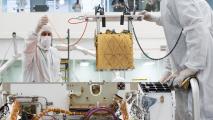
The New Space Race
Reusable rockets are real, the internet is in orbit, and we’re heading to Mars. With space manufacturing, asteroid mining, and lunar bases, the new space race has just begun, transforming life on Earth forever.
Read More
NASA’s asteroid sample contains an abundance of carbon and water
On October 11, NASA shared its first update on the Bennu asteroid sample brought to Earth by the OSIRIS-REx mission.
This massive autonomous cargo plane could slash shipping costs
A UK startup has an ambitious plan to slash the cost of air freight by shipping goods in a massive autonomous cargo plane.
T-Minus Weekly: An astronaut’s return, a Martian dust devil, and more
Freethink’s weekly countdown of the biggest developments in space, featuring the return of NASA’s Frank Rubio, a dust devil on Mars, and more.
“Forbidden planet” is orbiting a star that should have destroyed it
About 520 light-years from Earth, the planet Halla is orbiting a red giant that should have already engulfed and destroyed it.
Webb telescope spots strange objects in the Orion Nebula
New James Webb Space Telescope images of the Orion Nebula include more than 100 strange objects that are neither planets nor stars.
T-Minus Weekly: NASA’s first asteroid sample, Stoke’s big hop, and more
Freethink’s weekly countdown of the biggest developments in space, featuring NASA’s first asteroid sample, a Curiosity milestone, and more.
Why astronomers are excited about carbon dioxide and methane in the atmosphere of an alien world
Scientists reported chemical traces in the atmosphere of planet K2-18b, including a substance which on Earth is only produced by living things.
NASA has retrieved its first asteroid sample
NASA has just retrieved its first asteroid sample, bringing nearly 9 ounces of the asteroid Bennu to Earth.
Spending time in space can harm the human body − but scientists are working to mitigate these risks before we go to Mars
With NASA planning more missions to space in the future, scientists are studying how to mitigate health hazards that come with space flight.
Astronomers spot the first “bounce” in our Universe
Imprinted in the structure of the universe are “bouncing” signals from early on: where gravitating normal matter was pushed out by radiation.
Evidence suggests the world’s largest known asteroid impact structure is buried deep in southeast Australia
After years of asteroid impact research, experts think the world’s largest known impact structure is buried deep in the earth in Australia.
T-Minus Weekly: Victus Nox, a record-breaking ISS mission, and more
Freethink’s weekly countdown of the biggest developments in space, featuring the launch of Victus Nox, a record-breaking mission, and more.
T-Minus Weekly: The end of O2 on Mars and the week’s other big space stories
Freethink’s weekly countdown of the biggest developments in space, featuring the launch of XRISM, the end of MOXIE, and more.
NASA finishes the first experiment to make oxygen on Mars
NASA has officially wrapped up the Mars Oxygen ISRU Experiment (MOXIE), which was the first tech to generate oxygen on Mars.
SpinLaunch will hurl payloads into orbit, cutting the cost of launch by 20x
Rockets are big because they require enormous amounts of fuel. SpinLaunch’s method does away with much of that by hurling payloads into space.
NASA is spending $850,000 to make a bag for space trash
TransAstra has secured a $850,000 NASA contract to build an inflatable bag for capturing space trash, which could then be recycled in orbit.
“Ghostly” neutrinos help us see our Milky Way as never before
A unique photograph of the Milky Way galaxy was captured using the IceCube detector, which observes high-energy neutrinos from space.
NASA’s next-gen X-ray observatory is ready for launch (Updated)
XRISM is a next-gen X-ray observatory expected to revolutionize our understanding of the universe’s more energetic objects.
New moon map reveals structures hidden beneath the lunar surface
A new moon map that reveals structures hidden deep beneath the lunar surface also helps unravel the mystery of the moon’s past.
Subscribe to the newsletter





















